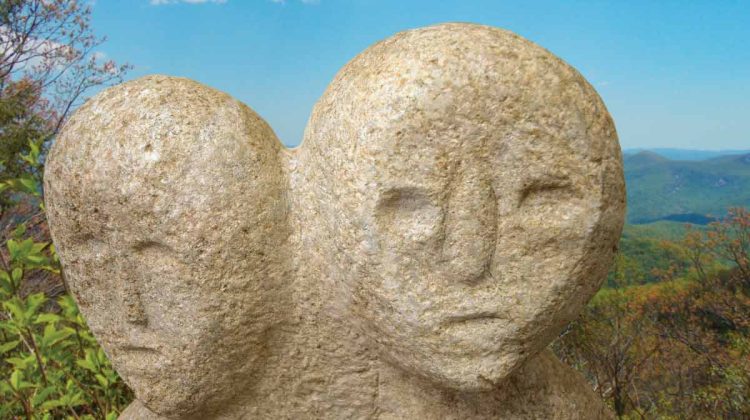
The trees have yet to bring forth their curtain of green, allowing riders to glimpse the hidden topography of the Blue Ridge Mountains. A sheer rock outcropping and scattered boulders peek out from the bare forest, tempting you to glance away from the twisting two-lane to see what’s hidden for most of the year.
Craggy rock overhangs and towering granite walls tempt my imagination into seeing them as ruined castles as I take a quick peek out of the corner of my helmet before rolling into the next bend. Long shadows drape across the road, creating an otherworldly sensation to traveling through these lonely mountains. The mysteries and folklore of the southern Appalachian Mountains make for an enticing reason to point your motorcycle toward those ancient hills.
The lure of such folktales and the chance to see some strange artifacts associated with them prompted me to venture deep in a corner of the Blue Ridge in search of the legend of the Moon-Eyed People, a mythical race of small, blue-eyed, underground-dwelling beings who inhabited this region centuries before the Cherokee arrived.
It was a photo of the statue that really motivated me to take a deeper journey into this legend. I’d heard the myth decades ago as a native of Western North Carolina. In college, I even explored the basement corridors where an urban legend says construction crews unearthed the little people’s tunnels while building McKee Hall at Western Carolina University in the 1930s.
A journey down the rabbit hole of YouTube videos offers a myriad of theories surrounding the legend. A lost expedition of Welsh explorers? A forgotten branch of human evolution? Aliens? I find a thread of logic in each tall tale, which only boosts my fascination.
There are essentially only two main roads to get to North Carolina’s westernmost town of Murphy: U.S. 64 or U.S. 74. If you’re in a hurry, U.S. 74 is the quickest and most efficient route. As motorcyclists, that’s usually not our primary reason for traveling by two wheels. I take the longer, but more scenic, route west along U.S. 64 through Highlands and down the Cullasaja Gorge, passing Bridal Veil and Dry falls.
Just north of U.S. 64 off N.C. 107, an excellent motorcycle route in itself, lies Judaculla Rock, a collection of mysterious petroglyph carvings by the ancient Cherokee that’s worth a detour. Experts tie the soapstone bolder to the legend of Judaculla, a one-eyed giant who terrorized the Cherokee if they strayed into his highland domain. Unfortunately, I’m chasing a different legend today and still have an hour’s riding to do before I flip down my kickstand.
The original route of U.S. 64 becomes Peachtree Street in Murphy and the de facto main street. Outside the Cherokee County Museum, located next to the Police Department, I spot another carved boulder I’ve only seen on web pages: a large tortoise. It watches silently as people pass along the sidewalk in front of it.
I bound up the stairs, eager to see this strange sculpture that my paranormal-obsessed brain has dreamed of seeing for months, and pay the modest admittance fee. The friendly and helpful museum director picks up the phone and calls the local expert, conveniently down the street, to come and share the story behind their prized artifact. I love small, mountain towns.
Billy Ray Palmer, a local historian and retired professor at Tri-County Community College, is the region’s foremost expert on the myths, legends and history of this corner of the state. He happily regales me with the story behind the statue, tossing in some trivia about the town of Murphy. (The town, named after a prominent 19th century politician, is actually a misspelling of its namesake). He tells me the Cherokee first arrived in these hills around 1100 A.D. but found they weren’t alone.
“They said in their myths that when they moved in here, there were already a group of people here,” Palmer said. “They were short, white, flat-faced and blue eyed. They were so blue-eyed they could not see to work in the bright sunshine, so they came out in the evening and nights to do their work. The Cherokee called them the Moon-Eyed People. Eventually the Cherokee displaced them or they migrated elsewhere.”
The rivers across the southeastern U.S. often drew native peoples to build settlements near them. Murphy, located in a broad valley where two rivers meet, became a welcoming spot for both the Cherokee and the European settlers who followed. As a motorcyclist, any road that follows a river is one I wish to follow as well. Perhaps the desire to be close to water also drew the mysterious little hominids called the Moon-Eyed People.
Palmer, a slim and amiable man, settles into a chair near a collection of fairy stones — another intriguing feature of Appalachia — as I listen with rapt attention.
“The Moon-Eyed People were on the east bank of the Valley River across from the Cherokee. According to the myths, the Moon-Eyed People were afraid to cross the river because of the ‘big red leech,’” Palmer said.
The Cherokee would test a young warrior’s bravery by making him cross the river where the big red leech lurked as a right-of-passage, Palmer said.
“What was the big red leech? In my opinion, it was a big catfish. It would have been red because of all the iron-ore down there,” he said.
Murphy’s River Walk allows visitors to stroll along the greenway by the confluence of the Valley and Hiawassee rivers, an area where much of the town’s early history unfolded. Palmer said he has seen 3-feet long catfish feeding near the river bank and noted a boy caught a 6-foot long catfish elsewhere in North Carolina a few years ago.
After the Indian removal in 1838 — Murphy was the site of Fort Butler, a collection area along the Trail of Tears where more than 3,000 Cherokee passed through on their forced march west — the area was sold off by the government. A settler purchased the site and unearthed the statue in 1840 while clearing the land for farming. Palmer said it was purchased by a motel owner and remained a local curiosity before eventually being put on display at the museum in 2015.
“We have had several archeologists and anthropologists look at it. They concur it’s authentic. It’s pecked out of soapstone and talc. It would’ve been whiter than it is now because of the soapstone and talc, but where it was found, there is a lot of iron ore in the river, probably what turned the catfish red, and it discolored the statue somewhat.
Staring into the flat faces and round eyes of the statue, which stands about four feet tall and weighs nearly 400 pounds, one cannot escape the similarities to modern pop-culture representation of aliens. The conjoined twins of the statue feature two figures of different heights. Palmer tells me he thinks they represent the twin rivers of the Hiawassee and Valley, where the Hiawassee is the larger “twin” and where they meet represents the location where Murphy was founded.
After perusing the impressive collection of arrowheads, fairy stones and pioneer memorabilia in the museum, I headed around the corner to one of my favorite restaurants in Murphy — Chevelles 66 Restaurant and Bar.
The hot-rod themed eatery has become my usual stop when passing through Murphy.
“Our parents started it. We grew up around cars. We threw in the name Chevelle at the last minute and it just kind of stuck with everybody, said Dean Butler, who runs the restaurant with his sister, Thea.
The restaurant and bar seem packed during the lunch rush as I settle in, feeling right at home next to the neon beer signs and automotive décor.
“We were tossing around a few different car names,” Thea said. “Stingrays? No, that doesn’t sound good. Impalas? Chevelles?”
The name stuck. A perfect mix of Americana and performance. Thea said they took the runner-up names and turned them into monikers for sandwiches and burgers.
“When we first opened, we actually had a ‘66 Chevelle sitting in the back of the restaurant,” Thea said.
The family business, along with their other restaurants in the area, offers a casual environment combined with high-quality food.
“I’d say I often describe the place as a burger-and-wing joint that also sells really nice food,” Dean said. “Big jumbo wings. We cut our own burgers. If you look at the menu, you’ll see it looks a little nicer, a little more high-scale.”
Indeed, what looks like a typical roadhouse offers travelers an unexpected culinary delight right in the middle of this remote mountain town. The Butlers tell me their father graduated from the Culinary Institute of America, instilling them with the dedication to offering the highest-quality food in a welcoming atmosphere. They opened Chevelles 66 in 2009, becoming a popular eating destination in the area, especially for motorcyclists transiting the region.
“We get motorcyclists — 20-people deep. We get a lot of people that are surprised. They come in here thinking it is a bar with burgers and wings, and then they’re like, Oh, I can get a filet? Or I can get a grouper that was fresh-caught yesterday? Or I can get oysters? We really pride ourselves on the quality of our food. Everything comes fresh. Nothing is frozen,” Thea said.
Like any good roadside stop, a stage in the corner hints at entertainment options, making Murphy a good place to stay for a weekend outing.
“We do tons of live music. We like to get a lot of different bands and music. We like to bring things into the community that they can’t get or nobody else is offering. We pull bands that are local, but we also pull bands from Nashville, from Florida. We’re pulling people in to give the widest range of music,” Thea said.
Dean and his father are also motorcyclists who enjoy the backroads in this corner of the state bordering Georgia and Tennessee.
“My dad rides a new (Harley-Davidson) Pan America, and I have a new (Yamaha) Tenere 700. We grew up on regular street Harleys. My first bike was a Sportster. We switched to adventure bikes. There are a lot of nice roads here. You go down any backroad, you have a great on-the-road experience. There is a nice little loop even here in Murphy. You can go up through Hanging Dog to Tellico Plains and back over the mountain, which is all gravel, or you can switch the other direction, which is all pavement, and come by Hiawassee Dam.”
Murphy’s location near Deal’s Gap the famed Tail of the Dragon always attracts motorcyclists, but some of the real treasures for motorcyclists remain hidden in this remote mountain valley.
“There’s a lot of nice, just general motorcycle roads here that a lot of people don’t know about and aren’t talked about much. The Tellico ride is nice. You can get to Bald River Falls,” Dean said.
Indeed, the gravel roads crossing the mountainous border between North Carolina and Tennessee prove to be a wonderland for adventure riders.
“You will think you have made a wrong turn. You will be in the middle of the woods, just gravel, and then it opens up to the mountains, and you are like, ‘How did I get here?’” Thea said.
Eventually the road takes you into Tennessee and back to civilization, where you can pick up the famed Cherohala Skyway to return to North Carolina.
All my years of motorcycling have taught me to always take the roads locals mention. I leave town on the Unicoi Turnpike along the Hiwassee reservoir. It’s a nice, tree-lined drive, and I stop at the Hanging Dog Recreation Area, where the Tennessee Valley Authority dam makes the tumbling waters of the Hiawassee calm and smooth. This time of year, the water level is low as the TVA draws down the lake for power generation.
The red-soil banks of the reservoir rise above the placid waters. I search for a giant red leech, like the one that the Moon-Eyed People feared, but nothing stirs. I’m tempted to point the bike south to Fort Mountain, Georgia, about 60 miles southwest.
This state park near Ellijay in the Peach State features an 885-foot-long zig-zagging rock wall of ancient origin. Some say the wall was a last-ditch fortification by the Moon-Eyed People in their war with the Cherokee. Some say it was built by the Cherokee themselves for ceremonial reasons. Whatever you believe, it is worth a trip there. A few miles west, near the petroglyphs of Track Rock Gap, more remnants of rock walls can be found in the Chattahoochee National Forest. Experts debate their origin, but I like to think the Moon-Eyed People once inhabited a mountain lair.
As I speed by on my motorcycle, glancing from the corner of my visor, a part of my subconscious tempts me to think I saw one of those small, pale and blue-eyed creatures peeking over a rock as my liter bike screams past their hidden ancestral home.
Even if it was a figment of my imagination, riding through the lonely roads where these mythical creatures may have lived is worth a day of exploring this enchanting land.


